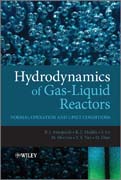
Hydrodynamics of gas-liquid reactors: normal operation and upset conditions
Azzopardi, Barry
Zhao, Donglin
Yan, Y.
The design of chemical reactors and their safety are as critical to the success of a chemical process as the actual chemistry taking place within the reactor. This book provides a comprehensive overview of the practical aspects of multiphase reactor design and operation with an emphasis on safety and clean technology. It considers not only standard operation conditions, but also the problems of runaway reaction conditions and protection against ensuing over-pressure. Hydrodynamics of Multiphase Reactors addresses both practical and theoretical aspects of this topic. Initial chapters discuss various different types of gas/liquid reactors from a practical viewpoint, and later chapters focus on the modelling of multiphase systems and computational methods for reactor design and problem solving. The material is written by experts in their specific fields and will include chapters on the following topics: Multiphase flow, Bubble columns, Sparged stirred vessels, Macroscale modelling, Microscale modelling, Runaway conditions, Behaviour of vessel contents, Choked flow, Measurement techniques. INDICE: List of Figures. List of Tables. Preface. Nomenclature. 1. Introduction. Part One. 2. Bubble Columns. 2.1 Introduction 6 2.2 Types of Bubble Columns. 2.3 Introduction of Gas. 2.3.1 Methodology of Gas Injection. 2.3.2 Bubble Formation and Size Change. 2.3.3 Bubble Movement. 2.3.3.1 Bubble Shape. 2.3.3.2 Bubble Motion. 2.3.3.3 Bubble Velocity. 2.3.3.4 Effect of Multiple Bubbles. 2.3.4 Void Fraction Prediction. 2.3.5 Detailed Behaviour of the Flow. 2.3.6 Gas-Liquid Mass Transfer. 2.3.7 Design of Gas Introduction Arrangement. 2.3.8 Worked Example. 2.4 Disengagement of Liquid from Gas. 2.4.1 Mechanisms of DropFormation. 2.4.2 Drop Capture. 2.4.3 Wave Plate Mist Eliminators. 2.4.4 Mesh Mist Eliminators. 3. Sparged Stirred Vessels. 3.1 Introduction. 3.2 Flow Regimes. 3.3 Variations. 3.4 Spargers. 3.5 Impellers. 3.5.1 Disc Turbines. 3.5.2 Pitched Blade Turbines. 3.5.3 Hydrofoil Impellers. 3.5.4 Multiple Impellers. 3.6Baffles. 3.7 Power Requirements. 3.7.1 Single Impellers. 3.7.2 Multiple Impellers. 3.7.3 Single-Phase Power. 3.8 Gas Fraction. 3.9 Mass Transfer. 3.9.1 Bubble Size. 3.9.2 Interfacial Area. 3.9.3 Mass Transfer. 3.10 Mixing Times. 4. Thin Film Reactors. 4.1 Introduction. 4.2 Falling Film Reactors. 4.2.1 Film Thickness. 4.2.2 Interfacial Waves. 4.2.3 Heat and Mass Transfer. 4.3 Rotating Disc Reactors. 4.3.1 Film Thickness. 4.3.2 Interfacial Waves. 4.3.3 Mass Transfer. 4.4 Two-Phase Tubular Reactors. 4.5 Monolith Reactors. 4.5.1 Micro-Channels. 4.5.2 Flow Phenomena in Micro-Channels. 4.5.3 Numerical Modelling. 5. Macroscale Modelling. 5.1 Introduction. 5.2 Eulerian Multiphase Flow Model. 5.2.1 Definition. 5.2.2 Transport Equations. 5.2.2.1 Continuity Equation. 5.2.2.2 Momentum Equation. 5.2.2.3 Energy Equation. 5.2.3 Interfacial Forces. 5.2.3.1 DragForce. 5.2.3.2 Lift Force. 5.2.3.3 Virtual Mass Force. 5.2.3.4 Turbulent DragForce. 5.2.3.5 Basset Force. 5.2.3.6 Wall Lubrication Force. 5.2.4 TurbulenceModels. 5.2.5 Case Study Cylindrical Bubble Column. 5.2.6 Homogenous and Mixture Modelling. 5.2.6.1 General Formulation. 5.2.6.2 Mixture Model. 5.3 Poly-Dispersed Flows. 5.3.1 Methods of Moments. 5.3.1.1 Breakup Model. 5.3.1.2 Coalescence Model. 5.3.2 Case Study Hibiki's Bubble Column. 5.3.2.1 Numerical Solution Method. 5.3.2.2 Results and Discussion. 5.3.2.3 Summary of Case Study. 5.4 Gassed Stirred Vessels. 5.4.1 Impeller Model. 5.4.2 Multiple Reference Frame. 5.4.3 Multiple Impellers. 5.5 Summary. 6. Mesoscale Modelling Using the Lattice Boltzmann Method. 6.1 Introduction. 6.2 Lattice Boltzmann Method and the Advantages. 6.3 Numerical Simulation of Single-Phase Flow and Heat Transfer. 6.3.1 LBM Model. 6.3.2 Treatment for a Curved Boundary. 6.3.3 Numerical Simulationand Results. 6.4 Numerical Simulation of Two-Phase Flow. 6.4.1 Two-Phase Lattice Boltzmann Model. 6.4.2 Vortices Merging in a Two-Phase Spatially Growing Mixing Layer. 6.4.3 Viscous Fingering Phenomena of Immiscible Two-Fluid Displacement. 6.4.4 Bubbles/Drops Flow Behaviour. 6.
- ISBN: 978-0-470-74771-1
- Editorial: John Wiley & Sons
- Encuadernacion: Cartoné
- Páginas: 344
- Fecha Publicación: 01/07/2011
- Nº Volúmenes: 1
- Idioma: Inglés
